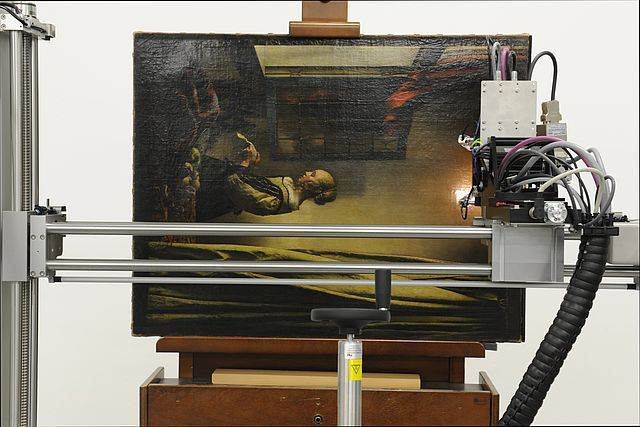Restoration Reveals Long-Lost Cupid Painted Over After Vermeer’s Death
In an unusual move, the Dresden gallery has opted to display the half-restored painting prior to concluding conservation efforts
/https://tf-cmsv2-smithsonianmag-media.s3.amazonaws.com/filer/a3/64/a3648d22-a62c-4666-ac9a-cbc07e74232b/csm_am-1336-pr01_c544d3142d_copy.jpg)
Johannes Vermeer’s “Girl Reading a Letter at an Open Window” has a decidedly protracted provenance. Attributed first to Rembrandt and later to Pieter de Hooch, the canvas was only identified as a Vermeer original in 1862. During World War II, the contemplative scene narrowly escaped destruction in the firebombing of Dresden, but then fell into the hands of the invading Soviets, who refused to return the plundered painting until 1955.
Now, ongoing restoration work has added yet another wrinkle to the story of the 1657 masterpiece: As Germany’s Staatliche Kunstsammlungen Dresden announced earlier this week, a recent bout of laboratory testing confirmed that a long-hidden Cupid found in the top right-hand corner of the canvas was painted over not by the Dutch Golden Age artist, but an unknown party who acted decades after Vermeer’s death. Although art historians have known of the little god of love’s existence since 1979, they previously believed Vermeer covered up the figure himself and, as a result, decided against restoring the painting to its original form.
According to a press release, conservators opted to remove the overpainting in lieu of their discovery, but rather than waiting until the process is complete to return the work to its place in the museum’s Gemäldegalerie Alte Meister, they have decided to pause halfway through so that Cupid—or more specifically his head and upper body—can finally make his public debut. Between May 8 and June 16, visitors will be able to view the painting, complete with a semi-unveiled Cupid painstakingly exposed by scalpel scraping, before it returns to the studio for the final stages of restoration.
As artnet News’ Kate Brown reports, conservator Christoph Schölzel began working on the painting in 2017, using X-ray, infrared reflectography imaging and microscopic analyses to examine its underlying layers. These tests, conducted in conjunction with research on the canvas’ restoration history, offered decisive proof that Vermeer was not the one responsible for replacing Cupid with a blank wall.

“There was even a layer of dirt above the original varnish on the Cupid, showing the painting had been in its original state for decades,” senior conservator Uta Neidhardt tells the Art Newspaper’s Catherine Hickley. The overpainting’s coloring, which was slightly darker than that of Vermeer’s background, also spoke to the layer’s later date, as the second artist had to match darkening varnish on the original.
“This is the most sensational experience of my career,” Neidhardt says. “It makes it a different painting.”
Interestingly, Hickley notes that the hidden Cupid, seen standing in a framed portrait on the wall behind the painting’s central figure, closely mirrors a depiction of the god found in “A Young Woman Standing at a Virginal,” a 1670-72 Vermeer owned by London’s National Gallery. It’s possible both works were based on a real painting in the artist’s possession; a 1676 inventory of his widow’s belongings cites “a Cupid.”
The newly revealed Cupid adds a new level of meaning to the painting. Whereas the scene previously offered no clues to the eponymous letter’s content, the god of love’s presence places the scene in a different context. Perhaps the girl, attention fixed on the crumpled paper in her hands, has just had her heart broken by an uncaring lover. On a more positive note, it's equally possible Cupid’s watchful gaze is a sign of the subject’s luck in love.
/https://tf-cmsv2-smithsonianmag-media.s3.amazonaws.com/accounts/headshot/mellon.png)
/https://tf-cmsv2-smithsonianmag-media.s3.amazonaws.com/accounts/headshot/mellon.png)